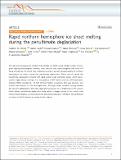Rapid northern hemisphere ice sheet melting during the penultimate deglaciation
Abstract
The rate and consequences of future high latitude ice sheet retreat remain a major concern given ongoing anthropogenic warming. Here, new precisely dated stalagmite data from NW Iberia provide the first direct, high-resolution records of periods of rapid melting of Northern Hemisphere ice sheets during the penultimate deglaciation. These records reveal the penultimate deglaciation initiated with rapid century-scale meltwater pulses which subsequently trigger abrupt coolings of air temperature in NW Iberia consistent with freshwater-induced AMOC slowdowns. The first of these AMOC slowdowns, 600-year duration, was shorter than Heinrich 1 of the last deglaciation. Although similar insolation forcing initiated the last two deglaciations, the more rapid and sustained rate of freshening in the eastern North Atlantic penultimate deglaciation likely reflects a larger volume of ice stored in the marine-based Eurasian Ice sheet during the penultimate glacial in contrast to the land-based ice sheet on North America as during the last glacial.
Citation
Stoll , H M , Cacho , I , Gasson , E , Sliwinski , J , Kost , O , Moreno , A , Iglesias , M , Torner , J , Perez-Mejias , C , Haghipour , N , Cheng , H & Edwards , R L 2022 , ' Rapid northern hemisphere ice sheet melting during the penultimate deglaciation ' , Nature Communications , vol. 13 , 3819 . https://doi.org/10.1038/s41467-022-31619-3
Publication
Nature Communications
Status
Peer reviewed
ISSN
2041-1723Type
Journal article
Description
Funding: The research was funded by HIDROPAST (CGL2010-16376) OPERA (CTM2013-48639-C2-1-R) and CHIMERA (CTM2016-75411-R) all to HMS, IC, and AM, and ETH core funding to HS. JT and MI were funded by doctoral FPI fellowships of CTM2013-48639-C2-1-R, and OK by doctoral Fellowship ETH-13 18-1. CP and HC acknowledge NSFC Grant 41888101, AM acknowledges CGL2016-77479-R, and R.L.E acknowledges NSF 1702816 and the 111 program of China grant D19002. IC and JT acknowledge Generalitat de Catalunya Grups de Recerca Consolidats grant 2017 SGR 315 to GRC Geociències Marines, and IC acknowledges the ICREA-Academia programme from the Generalitat de Catalunya and PID2019-105523RB-I00. EG is funded by a Royal Society University Research Fellowship (R1/180317).Collections
Items in the St Andrews Research Repository are protected by copyright, with all rights reserved, unless otherwise indicated.

